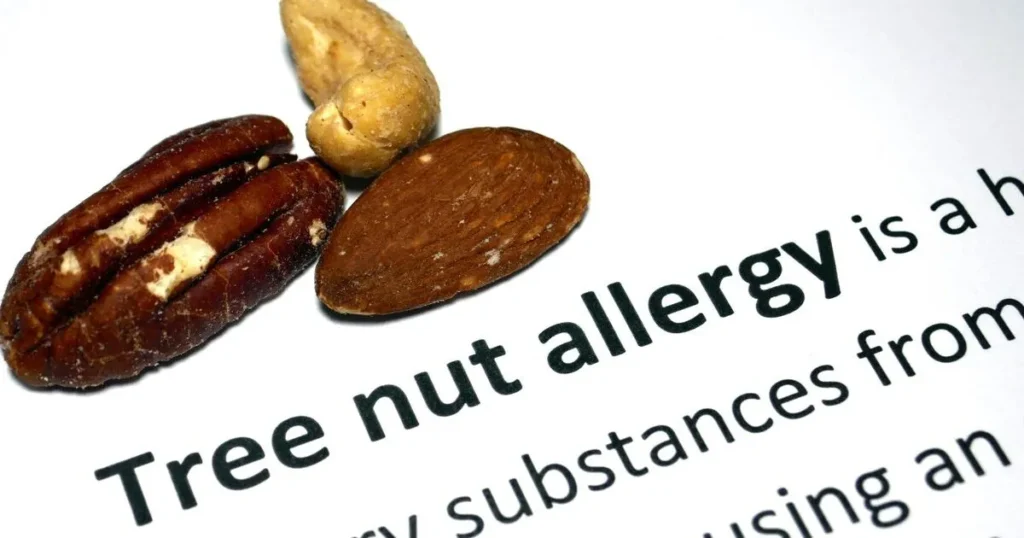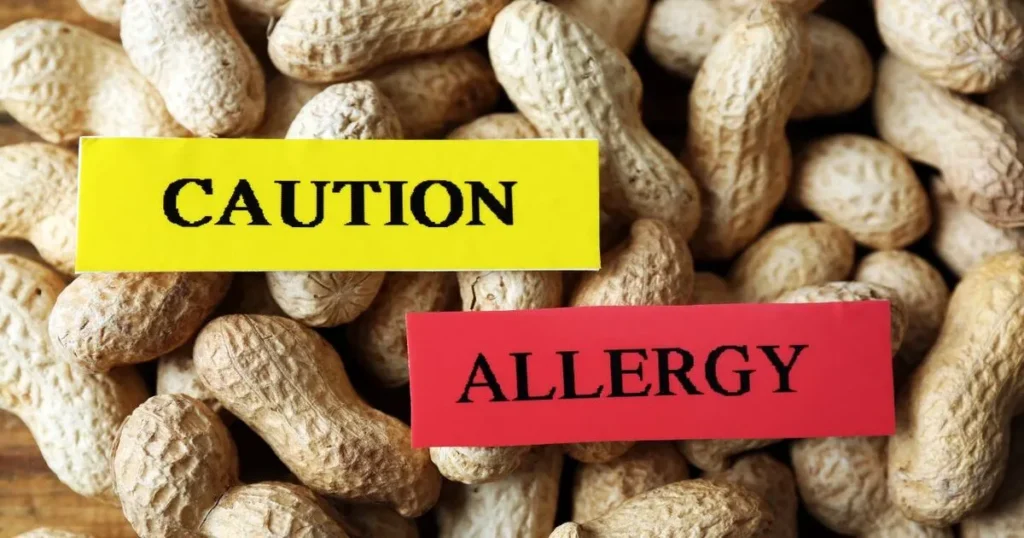The Ultimate Guide to Understanding Nut Allergy in Kids

You’ve just handed your toddler a slice of grandma’s homemade banana bread. In less than a few minutes, their face starts turning red and splotchy. Your heart races. You think, “Could this be an allergic reaction?” If you’ve found yourself in scenarios like this, you’re far from alone.
Nut allergy in kids, including both peanut allergies and tree nut allergies, are on the rise, especially among children. The stakes are high; the symptoms can range from mild discomfort to life-threatening reactions.
In this comprehensive guide, we’ll tackle everything you need to know about nut allergies in children. From signs and symptoms to diagnostic methods and treatment options, we’ll equip you with the essential knowledge to help keep your little ones safe.
Nut Allergy in Kids: What’s the Real Deal?
“Why does my child react to nuts like they’re a villain from a superhero movie?” you may ask. Well, it’s all about the proteins. These little guys make certain peanuts and tree nuts look like foes to your child’s immune system. And the immune response? A flood of chemicals, including histamines, swings into action. The end result? Symptoms of a severe allergic reaction kick in. Ah, the drama of the human body!
Two Categories of Culprits: Peanuts vs. Tree Nuts
Let’s get something straight: not all nuts are created equal in the allergy world. Peanuts, despite their misleading name, aren’t even real nuts; they’re legumes! On the flip side, tree nuts are the “true nuts” and they come in a variety of characters: almonds, cashews, walnuts, and more.
So, what’s the big deal? Here it is: Both types have a leading role in the world of food allergies. They’re part of the notorious ‘Big 8’ the eight foods most likely to cause allergic reactions.
The Numbers Speak: Prevalence of Nut Allergies
Food allergies are no joke. About 5% of children in the U.S. have them, and nuts are often the headline-grabbers. Both peanuts and tree nuts, along with seafood, can lead to intense, life-threatening reactions.
And here’s a number that might make you pause: 2.5% of kids are allergic to peanuts, a number that’s surged 20% since 2010, according to the American College of Allergy, Asthma, and Immunology.
The Nutty Connection: Peanuts and Tree Nuts
Ever stood in the grocery aisle, lost in thought, deciding between almond and peanut butter? Your gut feeling may have been more accurate than you think. Studies indicate that between 25-40% of peanut-allergic individuals might also react to tree nuts. Yes, you heard that right! Your child may not just be allergic to one but both categories of nuts.
Takeaways: What Now?
Remember the time you spent decoding food labels to see if they contain tree nuts or peanuts? It pays off. Knowledge is your best tool to help your child navigate the world of food allergies. If your child has a nut allergy, it’s crucial to consult with healthcare professionals for proper diagnosis and management. Because when it comes to allergies, it’s always better to be safe than sorry.
Now, how about making that shift from nut butter to seed butter? Sounds like a plan!
Did You Know?
According to the American College of Allergy, Asthma, and Immunology, peanut allergies in children have surged by 20% since 2010. Scary, isn’t it?
Recognizing the Tell-Tale Signs: Is Your Child Reacting to Nuts?
So, you’ve given your little one a snack, and it happens to contain tree nuts. Now what? Your parental radar is buzzing, and you’re scrutinizing every move, every expression. What should you keep an eye out for?
The Typical Symptoms: What You Probably Know
Mild Reactions: Ever seen those pesky hives or your kiddo scratching their mouth? Mild nausea can also be a signal.
Severe Reactions: Hold on; we’re getting into red-alert territory here. Difficulty breathing, severe anaphylaxis, and fainting are no jokes and warrant immediate medical attention.
Food Allergies That Fly Under the Radar
Ever seen your child unusually grumpy or wincing in abdominal pain after eating? These subtle signs might be the immune system’s quiet alarm bells. These symptoms can happen and may be harder to connect to an allergy, especially if your child is too young to express what they’re feeling.
Which Nuts Are the Usual Suspects?
According to experts like Dr. Stephanie Leeds, peanuts often take the lead in causing allergic reactions in children. But don’t let your guard down with tree nuts! Cashews and walnuts have been named as frequent troublemakers.
The Timing of Allergic Reactions: What to Expect
Quick or slow? The onset of symptoms may tell you more than you think. Most allergic reactions are immediate, often occurring within minutes to two hours after snacking on nuts. If symptoms surface almost immediately, chances are the reaction is more severe, says Dr. Tiffany J. Owens.
The Spectrum of Symptoms
The truth is, that nut allergies are chameleonic. The symptoms vary from child to child and also depend on how allergic your child is to a particular nut. Some children who are allergic need only a minuscule amount of nut exposure for symptoms to manifest. Johns Hopkins Medicine notes that a crumb as tiny as 1/44,000 of a peanut kernel can cause symptoms.

Age Matters: Symptoms Through the Years
For younger children like infants and toddlers, hives and vomiting are often the giveaways, says Dr. Wendy Sue Swanson. Older kids? They might experience a more extensive list of symptoms, including wheezing, eyelid swelling, and severe reactions like anaphylaxis.
Symptoms You Might Overlook
Feelings of confusion or a vague sense of impending doom in a child might be overlooked but are significant. Especially in children who can’t articulate what they’re feeling, such symptoms may be your only clue.
Actionable Advice: Your Next Steps
The golden rule to manage an allergic reaction is to avoid the allergen. But let’s be realistic, accidental exposures happen. If you suspect your child has a tree nut allergy, or any allergy for that matter, consult a healthcare professional for diagnosis and a management plan.
Remember, many tree nut allergies are lifelong. Your child may not outgrow them, so learning to manage symptoms is key. If symptoms occur, especially severe ones like anaphylaxis, seek emergency medical help immediately.
The Takeaway
Nut allergies are complex, and symptoms can manifest in myriad ways. If you suspect your child is allergic, consult a healthcare professional and always be prepared for emergencies. Because in the world of allergies, it’s better to be over-prepared than under.
Nut Allergies in Children: Signs and Symptoms
Navigating the world of food allergies, especially when your child has a peanut or tree nut allergy, can be like tiptoeing through a minefield. So, what do you need to know when that alarm bell of concern starts ringing in your mind?
Mild Reactions: The Subtler Side of Nut Allergies
Let’s start with the mild stuff. Ever seen your kid with a runny nose after a nutty snack? Or maybe they’re scratching their mouth and complaining of some belly ache. These are often the subtle signs of a less severe allergic reaction. Dr. Leeds mentions that a few “isolated hives” or slight swelling on one side of the lip could also indicate a milder reaction.
Code Red: What a Severe Allergic Reaction to Nuts Looks Like
Now, if we’re talking severe, don’t hit the pause button—act immediately. Trouble breathing, full-body hives, or feeling faint are severe symptoms of anaphylaxis, a life-threatening reaction that requires immediate medical intervention.
If you have an EpiPen, now’s the time to use it. Dr. Owens emphasizes that severe reactions usually happen quickly post-exposure and could include scary symptoms like eyelid swelling, repetitive vomiting, or even drooping.
Trust Your Instincts: When to Ring the Alarm
Look, parents have a sixth sense for their kids’ well-being. If you suspect your child is having a severe allergic reaction, don’t hesitate. Administer the emergency medication, call 911, and get medical help, pronto. When it comes to severe reactions, it’s a ‘better safe than sorry’ kind of deal.
Peanut and Tree Nut Allergies: What Makes Them Different?
Peanut allergy in children is one of the most common food allergies, but did you know that being allergic to peanuts doesn’t necessarily mean your child will also be allergic to tree nuts like almonds or Brazil nuts? However, Dr. Owens points out that people with a tree nut allergy may also be allergic to peanuts, given that both contain similar proteins.
The Long Game: Lifelong Allergies and Testing
Unlike egg allergy, which some children outgrow, tree nut allergies are lifelong in many cases. So, if you’ve got concerns, consider allergy testing. A skin prick or a blood test can provide valuable insights. Food Allergy Research and Education recommends being cautious about foods that might contain tree nuts or peanuts, as even trace amounts can cause symptoms.
Prevention and Treatment: The Ongoing Battle
Early diagnosis can be critical in the prevention of peanut allergy. Pediatric allergy and immunology experts often recommend early introduction of peanut proteins to infants to reduce the risk of developing peanut allergy later on. However, always consult a healthcare provider for tailored advice.
Your Takeaway: Be Prepared, Be Informed
In the labyrinth of food allergen labeling and consumer protection laws, the best tool you have is awareness. Understand the signs and symptoms, get tested for peanut and tree nut allergies, and always have an emergency plan. It’s your front-line defense in the daily battle against food allergies. Remember, your intuition is a powerful ally—trust it.

The ABCs of Addressing Nut Allergies in Children
Navigating the terrain of your child’s nut allergy can be a labyrinth of concerns and precautions. Here’s a practical guide to help you find your way.
First Stop: Your Pediatrician or an Allergist
Think your child might be allergic to peanuts or tree nuts? Time to consult a specialist. Dr. Leeds advises that your first port of call should ideally be a board-certified allergist experienced in food allergies. Often, your pediatrician will be your gateway to this specialist if they suspect a nut allergy.
The Anatomy of Allergy Testing
Before diving into allergy tests like blood tests and skin prick tests, a detailed history of your child’s past exposures and reactions is crucial. Why? Dr. Leeds states, “Allergy tests can yield ‘false positives,’ so a comprehensive history is essential.
Here’s a rundown of tests you might encounter:
Label-Reading 101: Avoiding Hidden Nut Traps
Once a nut allergy is confirmed, your grocery shopping trips will evolve. Peanut oil, nut protein, and even ambiguous labels that say “may contain peanuts or tree nuts” become red flags. Products like baking mixes, sauces, and pre-packaged snacks are frequent culprits.
The Fine Print: Watch for Cross-Contamination
“Product was manufactured on equipment shared with tree nuts or peanuts” is a warning you can’t afford to ignore. Cross-contamination is a sneaky way your child can be exposed to allergens.
Your Arsenal: Medication and Individualized Treatment Plans
Your toolbox for managing nut allergies should always include medication for unexpected exposures. “For mild symptoms, an antihistamine like Benadryl can be a quick fix,” says Dr. Leeds. Severe symptoms? That calls for immediate use of an epinephrine auto-injector, commonly known as an EpiPen.
Besides medication, a robust conversation with your healthcare provider can help you tailor an individualized treatment plan. From avoiding nuts to understanding labels and sorting through treatment options, such a plan will be your roadmap.
The Playbook for Proactive Peanut Allergies Prevention and Response
Ever get that gut feeling that your child might be at risk for nut allergies? Whether it’s a family history or just parental intuition, you’re likely wondering what can be done to dodge this dietary dilemma. Let’s break down your preventative strategies and response game plan.
Early Introductions: The Case for 4-6 Months
When it comes to allergy prevention, timing might be everything. Dr. Swanson points out that both the Academy of American Pediatrics (AAP) and the USDA suggest introducing common allergens, including nuts, to children as young as 4-6 months. This early introduction seems to be especially crucial for kids at higher risk due to family history. The caveat? Always consult your pediatrician before introducing new foods, especially potential allergens.
Crafting Your Allergy Action Plan
So you’re clued up on prevention, but what if your child does show signs of an allergy to peanuts or other nuts? First, breathe. Then, activate your allergy action plan.
Your action plan should be something you’ve previously discussed with your pediatrician and it should include:
Spotting the Signs and Taking Action
Allergies can cause an allergic reaction that ranges from mild to severe. Mild symptoms might prompt a call to your pediatrician, but severe symptoms like trouble breathing or signs of shock mean you need to act quickly. In severe cases, this is a 911-level emergency.
Final Thoughts
Discovering that your child may be allergic to nuts can catapult you into a whirlwind of emotions—panic, concern, and a whole lot of ‘what now’? While it’s natural to feel this way, taking quick and decisive action is vital.
For milder symptoms, a call to your pediatrician can help you evaluate the situation and possibly schedule an in-depth check-up. But if your child shows signs of a severe allergy—trouble breathing, full-body hives, severe lethargy, or vomiting—don’t second-guess. Dial 911 or rush to the nearest emergency room.
Preparedness Over Panic
In a world where even the mere scent of peanuts can trigger an allergic reaction, you can never be too prepared. Work closely with your pediatrician, know the signs, and always have your allergy action plan at the ready. Your vigilant action today lays the groundwork for your child’s safer tomorrow.






